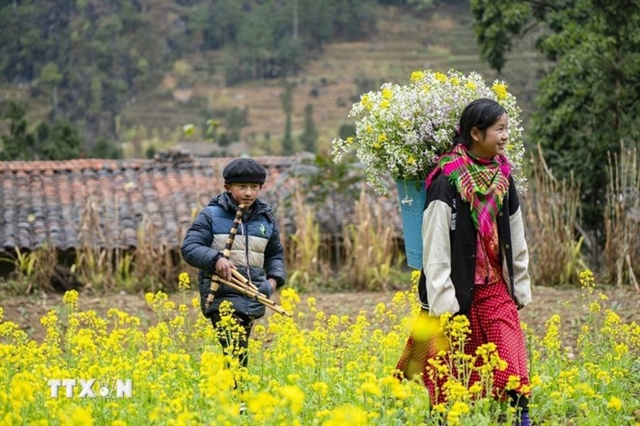 Life & Style
Life & Style


|
| Foreign tourists explore Tuyên Quang tourism. — VNA/VNS Photo |
HÀ NỘI — Mountain tourism is emerging as a key driver for sustainable development, offering not only globally significant archaeological, geological, and geomorphological values but also preserving the distinctive cultural and historical identities of local communities.
This sector holds vast promise for fostering eco-friendly growth while safeguarding natural resources and traditional heritage.
From geological treasures to tourist attractions
Việt Nam is home to four UNESCO-recognised Global Geoparks: Đồng Văn Karst Plateau (designated in 2010), Non Nước Cao Bằng (2018), Đắk Nông (2020), and Lạng Sơn (2024). Each geopark is regarded as a “living geological museum,” showcasing the harmony between natural grandeur and the rich cultural diversity of ethnic groups.
The Đồng Văn Karst Plateau draws visitors with its majestic limestone landscapes and the distinctive cultural life of the Mông, Dao, Lô Lô, and Tày communities. Non Nước Cao Bằng fascinates tourists with its interlaced limestone mountains, rivers and waterfalls, most notably Bản Giốc, as well as archaeological sites reflecting the cultural imprints of the Tày, Nùng, and Mông groups.
In the Central Highlands, Đắk Nông Geopark stands out with its extensive basalt volcanic cave system and the gong culture of the M’Nông and Ê Đê ethnic groups, recognised by UNESCO as an Intangible Cultural Heritage of Humanity. Lạng Sơn Geopark, meanwhile, features ancient rock formations, impressive caves, and vibrant ethnic cultural expressions.
Capitalising on these unique values, localities have developed a variety of tourism products that are gradually transforming geoparks into competitive assets. In Đồng Văn, popular destinations such as Tu Sản Canyon, Nho Quế River, Mã Pì Lèng Pass, Lũng Cú Flag Tower, the Vương Family’s Palace, and traditional ethnic villages have become major draws. The geopark now offers four themed travel routes encompassing 59 key sites.
Non Nước Cao Bằng Geopark has also introduced four tourism routes covering 57 attractions, including Bản Giốc Waterfall, Ngườm Ngao Cave, Phia Oắc–Phia Đén National Park, Pắc Bó Historical Site, and the traditional villages of Khuổi Ky and Hoài Khao. Likewise, Đắk Nông Geopark features three routes with 41 destinations such as Tà Đùng Lake, Dray Sáp Waterfall, Đắk Mil Prison, and N'Trang Gưh Memorial Site, while Lạng Sơn Geopark is developing four routes linking 38 locations of geological and cultural significance.

|
| Brilliant mustard blossoms. — VNA/VNS Photo |
Building distinctive and sustainable tourism products
Despite their natural and cultural richness, Việt Nam's geopark-based tourism remains underdeveloped, with noticeable gaps in both quality and sustainability.
Dr. Nguyễn Xuân Hải from the Việt Nam National University of Agriculture noted that the main constraint lies in the limited diversity and quality of tourism offerings. He pointed out that many unique geological features, such as nearly 50 volcanic caves in Đắk Nông Geopark, have yet to be fully explored or developed for tourism purposes.
He proposed classifying geopark tourism into three tiers: high-end scientific tours for experts and students; mid-range adventure and wellness tourism combining geological exploration with activities like trekking and kayaking; and basic cultural and heritage tourism featuring local cuisine, festivals, and historical sites.
Cao Quốc Chung, Deputy Director of Á Đông Vidotour Travel and Trading Co., Ltd., Hà Nội branch, emphasised that geopark tourism should provide tangible, sensory experiences that allow visitors to engage directly with both the landscape and its stories. Scientific and cultural elements, he said, should be seamlessly woven into the natural setting to create distinctive narratives for each destination.
Chung added that the Đồng Văn, Cao Bằng, and Lạng Sơn Global Geoparks form a continuous tourism corridor in the Northeast, but urged the development of diversified products to prevent duplication and foster healthy, complementary growth among these destinations. — VNA/VNS




